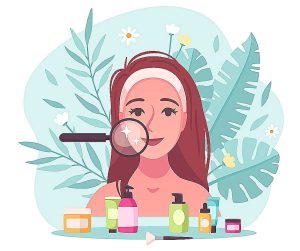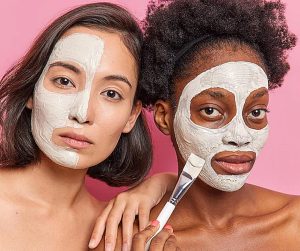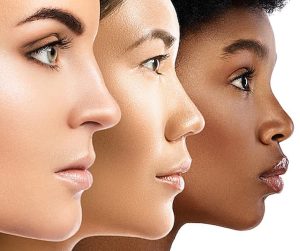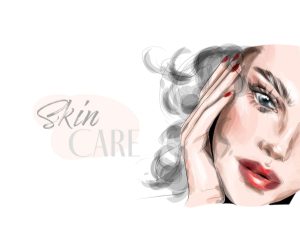How to know the best Cream/Moisturizer for your skin: A skincare components check can feel like reading a foreign language unless you have a background in Latin or a degree in chemistry. But that language does have a name; it’s called the International Nomenclature of Cosmetic Ingredients (INCI), and it was developed to assist standardize the language of ingredient names that would be used on labels throughout the world. And unfortunately, it is not user-friendly.
Sometimes, manufacturers try to help the average consumer by placing the more familiar name in parentheses next to the more technical name, for instance, tocopherol (vitamin E). But without that prod, an ingredients list frequently merely appears as a long list of strange terms, separated by commas.
In the era of beauty influencers, it can be simpler to follow trends and choose skincare products (and components) with a cult following rather than conducting research. However, it’s not always the greatest option. There is no one-size-fits-all skincare product. In other words, you may not benefit from a product your friend finds effective.
Finding the skincare products with the best ingredients for your skin requires an individualized approach. It takes a little more effort and persistence to do this, but it’s worthwhile.This article explores how to know the perfect cream for your skin.
Recommended: How to become the best version of yourself
What Is Body Cream?
Simply put, when the ratio of oil to water is skewed more heavily toward the oil, the product is referred to as a cream. Since the skin is the body’s largest organ, it needs to be taken care of using the proper product. A body lotion has a thin consistency and mild covering. Body cream, on the other hand, is heavier since it contains a higher percentage of oil.

Creams penetrate the skin and create a barrier that prevents the skin from losing more moisture than lotion. However, creams often leave the skin feeling greasier and heavier. Thus, some people prefer to apply creams at night because doing so enables the body to absorb all the nutrients it requires.
Body creams may additionally provide smoothing or brightening effects. The elbows, knees, feet, and hands are some tough places that creams are excellent for hydrating. The smooth, creamy texture of body creams also gives you an opulent, pampered-feeling sensation.

Recommended: Differences Between Water-resistant And Waterproof
How to Know the Perfect Cream/Moisturizer for Your Skin
These tips may help in your cream selection process.
1. KNOW YOUR SKIN TYPE: Your skin type is the most crucial criterion for selecting which skincare products would work best for you, according to cosmetic dermatologists. While not all creams are bad, it does occasionally happen that people with different skin types use the incorrect items for their skin type.
People with acne-prone or sensitive skin should be especially cautious when it comes to the substances in their skincare products. However, compared to other skin types, oily skin can tolerate a larger variety of ingredients that can sometimes cause breakouts or irritation for other skin types.
Also see: Differences Between A Monitor And A Television
FOR OILY SKIN
The use of a lot of moisturizers or creams may not be a good idea because some block the skin pores, thereby accelerating the rate of acne on the face or body. So it is better to use creams or moisturizers of drier and lighter components and which comprises of anti-aging properties. Acne has been discovered to cause discoloration of skin and strange darkening of skin in a number of people with black or brown colored skin. It is good to exfoliate but not so much; so as not to deprive the skin of its natural moisture. Alpha-hydroxyl acids are good for skins which produce excessive oil while hyaluronic acid face washes or creams and moisturizers keeps the skin hydrated.
FOR DRY SKIN
There is need to buy thick creams that will keep the skin wet and shiny. The moisturizers could be applied immediately after warm or cold bath, when water is still accumulated on your skin. You can apply thicker ones in the night, and apply a lighter version of the thick creams or moisturizers when going out in the day. Sometimes, creams or moisturizers which have fragrance may cause irritating reaction to the skin. The individual should look out for products with hyaluronic acid, petroleum jelly, glycerin and others which has hydrating properties or products with larger moisturizing composition. Little exfoliation removes dead skins and gives it a gleaming look.
FOR SENSITIVE SKIN
Because of its nature of being highly irritable and also the tenderness of this skin type, one should be careful of what one uses on it because it can be easily affected and prone to some unpleasant elements causing a lot of discomfort to the person. Individuals with this type of skin should be mindful of how they use products made with organics because they cause the skin react quickly to this or it may also result in a hypersensitive reaction. Even some creams and moisturizers containing alcohol and anti-bacterial properties have been shown to be abrasive to the skin. People with this skin type should use products that do not contain colors, fragrance or allergy properties. In summary, whatever products this set of individuals use on their skin should contain a minimal number of ingredients. Aloe Vera and Shea butter are good moisturizing agents for this type of skin. The skin should also be protected from the hot sun or other disastrous bright lights. Use of sun-screen containing SPF 30 and above. Use of sunglasses is highly recommended and beneficial for all skin types.
For a skin type that is both oily and dry:
The individual should watch out and pay more attention to these different areas when attending to any of them. This may be an individual’s head, nose and chin which may all pin-pointed to be on the center of the face. So when applying a cream or moisturizer, you should apply more of it on the dry parts of the face or body. It would also be nice to apply moisturizers and creams that have lighter texture and have medium-weight which will be helpful for the different but combined skin type.
INGREDIENTS
Make sure you review the ingredients before purchasing any cream brand. Be cautious of anything that can bleach your skin. If you have allergies, you should actively watch out for components that can trigger an attack.

Also see: How To Write A Book Summary (Step By Step)
2. SEEK OUT THESE INGREDIENTS
a. Glycerin: This ingredient is regarded as the backbone of moisturizing products.
Ceramides and hyaluronic acid: Important moisturizing elements, both of which are found in the skin naturally. Some dermatologists recommend going for hyaluronic acid in serum form and creams and lotions containing glycerin and ceramides.
b. L-Ascorbic acid (Vitamin C): L-ascorbic acid, a type of vitamin C, is an antioxidant that helps to repair UV radiation damage and promote the formation of collagen.
C. Tocopherol (Vitamin E): Vitamin E, also known as tocopherol, has properties that are similar to those of vitamin C and performs best when used together with the latter as a skincare duo.
D. Retinol: You should seek retinol as a significant element in any cream you use at night. It acts to activate collagen and renew skin cells.
E. Niacinamide (Vitamin B3): Niacinamide (Vitamin B3) is a fantastic oil-controlling agent that also moisturizes the skin and evens out skin tone.
F. Sun protection: Considerations for body creams should include those that shield your skin from damaging UV rays.

Also see: Differences Between Law And Statute
3. AVOID THESE INGREDIENTS
a. Fragrance/perfume: If you have sensitive skin, it’s especially crucial to stay away from creams with added fragrances because they might irritate and trigger skin allergies.
b. Sulfates: In body washes and shampoo, sulfates are common cleansing ingredients. However, they deplete the natural oil in the hair and skin and might cause irritation.
c. Parabens: Products frequently contain parabens as a chemical preservative to stop bacterial growth. They’re referred to as estrogen mimickers by industry experts, and they can be dangerous over time by upsetting hormonal balance. For young children and those at risk for breast cancer, this can be problematic.
d. Formaldehyde and formaldehyde releases: Since formaldehyde is now recognized as a proven carcinogen, it is uncommon to see it on an ingredient list. However, it’s frequently replaced by substances with alternative names (quaternium-15, DMDM hydantoin, Diazolidinyl urea, imidazolidinyl urea), which over time release formaldehyde to serve as preservatives.
Also see: Differences Between Extensive and Intensive Reading
4. ALWAYS DO A PATCH TEST
In your process of cream product elimination, a patch test is a wise practice. A patch test can help you assess whether specific products or chemicals will irritate your skin, clog your pores, or trigger allergic responses. In that case, it’s not the proper product for you if it irritates or aggravates your skin in any way, and hence you have to stop its usage.
Testing each product’s ingredients before utilizing them may take some time at first, but in the long run, you will become better for it as you get to save money and be stress-free.

Also see: Differences Between Goals and Objectives
5. DON’T BUY INTO THE HYPE
Packaging and popularity can be simple traps, therefore you shouldn’t place too much importance or value on them when choosing cream products for our skin. If you’re going to purchase a product based on a friend’s or influencer’s advice, you shouldn’t only consider how their current skin looks; you need also consider the type of skin they were previously dealing with. That will provide you with a more accurate indication of how effectively the product will serve your needs.
Occasionally, the use of the labels natural and organic on a product label serves more as a marketing ploy. Because those terms aren’t regulated and don’t have any established industry standards, they might offer bogus claims. So one has to be careful when seeking out such cream products.
Also see: Most Beautiful Cars In The World 2024 (With Pictures)
6. USE YOUR RESOURCES
Finding the right cream with the proper ingredients that suit you doesn’t require you to be a walking dictionary. Use online resources to your advantage to simplify things. Some internet resources for researching ingredients and skin care products include Environmental Working Group’s (EWG) Skin Deep database and CosDNA.
One area of their internet offerings is the EWG Skin Deep database. The Environmental Working Group (EWG) is a nonprofit organization dedicated to environmental and public health research and education. Skincare products are evaluated and ranked in the Skin Deep database based on a variety of criteria, such as production methods and potential health risks.
On the other hand, Cos DNA, a more straightforward database provides further information on a product’s ingredients’ unique roles and safety rating.
Also see: Differences Between Standard of Living and Cost of Living
Conclusion
In conclusion, purchasing good creams is very nice. It is a good thing to take proper care of your skin that it becomes so beautiful and admirable to look at. Although, we have different reasons of purchasing creams or moisturizers, many are narrowed down to be used for skin care. This is great; but sadly a lot of us have been duped of our money, induced skin diseases, discoloring and skin damages. Just because we were ignorant, or because we were carried away by the flattering words of the cream or moisturizer marketers and sellers. But after some enlightenment, we would take our time and buy a suitable cream or moisturizer for our skin or meet a skin doctor for assistance.

Edeh Samuel Chukwuemeka, ACMC, is a lawyer and a certified mediator/conciliator in Nigeria. He is also a developer with knowledge in various programming languages. Samuel is determined to leverage his skills in technology, SEO, and legal practice to revolutionize the legal profession worldwide by creating web and mobile applications that simplify legal research. Sam is also passionate about educating and providing valuable information to people.